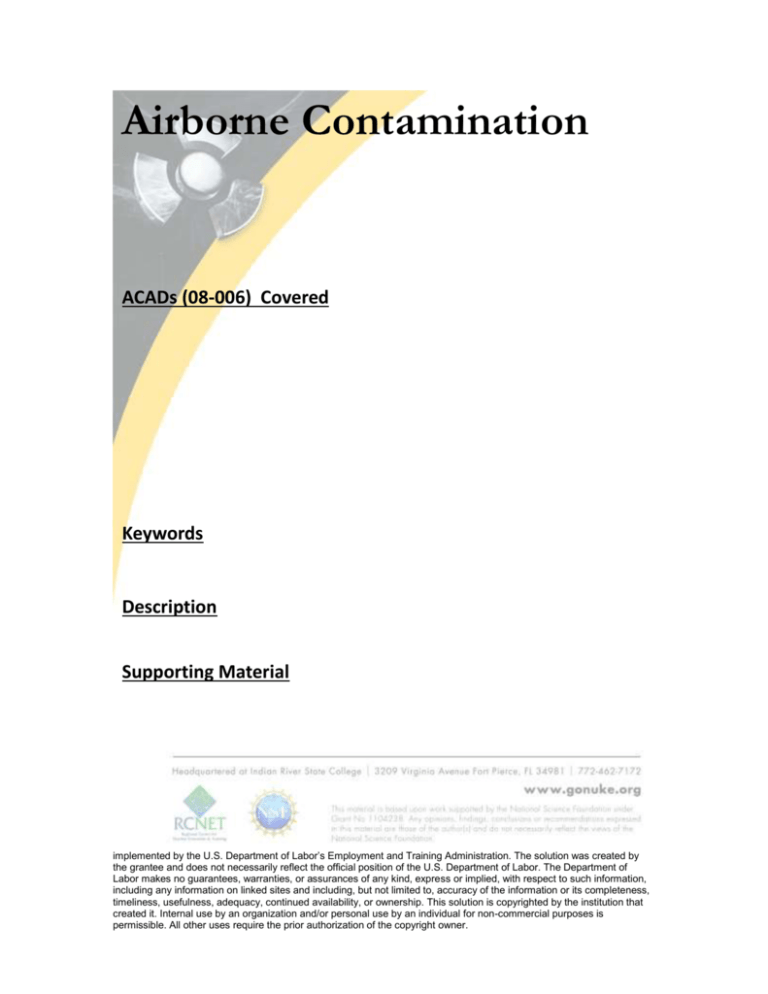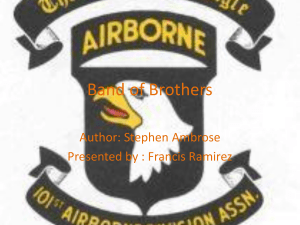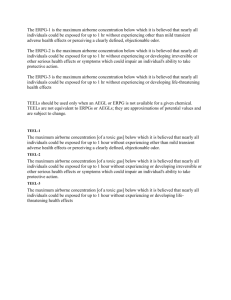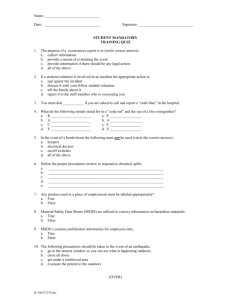
Airborne Contamination
ACADs (08-006) Covered
Keywords
Description
Supporting Material
Copyright © 2008-2009 - Curators of the University of Missouri, in collaboration with Linn
State Technical College. All rights reserved. DMCA and other copyright information.
This workforce solution was funded by a grant awarded under the President’s High-Growth Job Training Grants as
implemented by the U.S. Department of Labor’s Employment and Training Administration. The solution was created by
the grantee and does not necessarily reflect the official position of the U.S. Department of Labor. The Department of
Labor makes no guarantees, warranties, or assurances of any kind, express or implied, with respect to such information,
including any information on linked sites and including, but not limited to, accuracy of the information or its completeness,
timeliness, usefulness, adequacy, continued availability, or ownership. This solution is copyrighted by the institution that
created it. Internal use by an organization and/or personal use by an individual for non-commercial purposes is
permissible. All other uses require the prior authorization of the copyright owner.
RPT 243
Instructional Resources
Module 6 Airborne Contamination
The Curators of the University of Missouri
Copyright © 2008-2009
A Product of DOL Grant # HG-15355-06-60
Page 1
RPT 243
Instructional Resources
Module 6: Airborne Contamination
Table of Contents:
Resources Key .................................................................................................................... 3
Module Readings and Homework ...................................................................................... 3
Primary Scenario “Inhalation Uptake of 60Co”............................................................... 3
Transfer Scenario “Contamination and Uptake of Personnel from 58Co Airborne
During Flood-up of the Reactor Refueling Cavity” ........................................................ 4
Transfer Scenario Original Event Descriptions .................................................................. 5
Transfer Scenario “Contamination and Uptake of Personnel from 58Co Airborne
During Flood-up of the Reactor Refueling Cavity” ........................................................ 5
Module Assessment Items .................................................................................................. 6
Primary Scenario “Inhalation Uptake of 60Co”............................................................... 6
ACAD References .............................................................................................................. 8
RPT 243 Instructor’s Guide
The Curators of the University of Missouri
Copyright © 2008-2009
A Product of DOL Grant # HG-15355-06-60
Page 2
RPT 243
Instructional Resources
Resources Key
This refers This reference:
to:
ACAD
National Academy for Nuclear Training, Uniform Curriculum Guide for
Nuclear Power Plant Technician, Maintenance, and Nonlicensed
Operations Personnel Associate Degree Programs, ACAD 08-006.
DOE-SG
Office of Environmental, Safety and Health: Radiological Control
Technician Training Site Academic Training Study Guide Phase I,
Project Number TRNG-0003
G.
Available at: http://nsedu.rnet.missouri.edu/docshare/. File is located
under the Docs/General Curriculum/DOE materials folder.
Gollnick, D. (2006). Basic Radiation Protection Technology, 5th Ed.
Pacific Radiation Corporation, Altadena, CA.
Module Readings and Homework
Primary Scenario “Inhalation Uptake of 60Co”
Core Concept: Techniques and precautions for avoiding radiological incidents involving
airborne contamination
Homework
Readings
Calculation Items
Non-calculation Items
G., Chap. 15, 688-689
N\A
N\A
DOE-SG-Mod 2.13-6 to 2.13-8
DOE-SG-Mod 2.11-10 to 2.11-11
Core Concept: Techniques and precautions for minimizing exposure from airborne
contamination
Homework
Readings
Calculation Items
Non-calculation Items
G., Chap. 11, 416 – 420
N\A
G., Chap. 11, # 22, 23, 24,
25
DOE-SG-Mod 2.07-3 to 2.07-14
G., Chap. 11, #S10
DOE-SG-Mod 2.07.04a-e
to 2.07.09
Core Concept: Techniques and precautions for containment of contamination and
airborne radioactivity
Homework
Readings
Calculation Items
Non-calculation Items
N\A
N\A
N\A
Module 6 Airborne Contamination
The Curators of the University of Missouri
Copyright © 2008-2009
A Product of DOL Grant # HG-15355-06-60
Page 3
RPT 243
Instructional Resources
Core Concept: Advantages and disadvantages of equipment used for minimizing exposure
to airborne contamination (i.e., CAMs, respirators)
Homework
Readings
Calculation Items
Non-calculation Items
G., Chap. 11, 480-486
N\AP
G., Chap. 11, # 24, 25
DOE-SG-Mod 2.18-6 to 2.18-8
DOE-SG-Mod 2.06-4 to 2.06-20
DOE-SG-Mod 2.18.05,
DOE-SG-Mod 2.06.01 to
2.06.08
Transfer Scenario “Contamination and Uptake of Personnel from
58
Co Airborne During Flood-up of the Reactor Refueling Cavity”
Refer to readings and homework for primary scenario above.
The complete text of the event for this scenario is in the section “Transfer Scenario
Original Event Descriptions” below.
RPT 243 Instructor’s Guide
The Curators of the University of Missouri
Copyright © 2008-2009
A Product of DOL Grant # HG-15355-06-60
Page 4
RPT 243
Instructional Resources
Transfer Scenario Original Event Descriptions
Use the complete text of these events to assess students’ ability to analyze the event, and apply
appropriate safety and response procedures.
Transfer Scenario “Contamination and Uptake of Personnel from
58
Co Airborne During Flood-up of the Reactor Refueling Cavity”
Description: On the ninth day of the refueling outage, the refueling cavity was being filled (floodup) at the rate of about 1,160 gallons per minute. At 0056, a portable radioactive air sampler
alarmed on the refueling floor. Non-essential personnel were directed to leave the refueling floor.
A backup air sample was taken which indicated 87.3% Derived Air Concentration (DAC). At the
time the reactor head lift was still in progress and the head was not set in its storage location until
0205. Thirty personnel were identified with EPRI Action Level I contamination, mostly 200-400
ccpm on their faces. Cobalt-58 was the predominant isotope identified in the personnel
contaminations and area air samples.
Causes: The apparent cause of the airborne radioactivity is believed to be either (1) refueling
water flow up through the reactor vessel that rapidly displaced air over dry surface contamination
on the upper Reactor Internals or (2) water cascading down to the lower cavity causing sufficient
turbulence to evolve airborne radioactivity.
Corrective Actions:
1. The Control Room and Outage Control Center were notified and the reactor building was
posted as a "Airborne Radioactivity Area" and access was restricted.
2. Decontamination and whole body counts of the 30 contaminated personnel were
completed within eight hours of the event. Each of the 30 workers received a low-level
uptake of Cobalt 58, which was attributed to the airborne contamination. The estimated
internal dose for each worker is 1-5 millirem.
3. The radiation protection manager met individually with each of the 30 contaminated
workers to discuss the event and review their specific radiation exposure.
4. Depending on the results of the Root Cause Evaluation alternate means of flooding up
the refueling cavity may be assessed and changes to both access and radiological
controls may be instituted.
Module 6 Airborne Contamination
The Curators of the University of Missouri
Copyright © 2008-2009
A Product of DOL Grant # HG-15355-06-60
Page 5
RPT 243
Instructional Resources
Module Assessment Items
Note: If instructors wish to increase the difficulty of any item, then we suggest
you use it as the basis for an in-class discussion, and / or require students to
write an explanation for why a particular choice is correct.
Primary Scenario “Inhalation Uptake of 60Co”
Sally, a Radiation Protection Technician at a nuclear power plant, is providing radiological
coverage for a valve replacement. A six-inch valve in a radioactive system is being replaced with
a new one. The old valve has been cut out of the system and both pipe ends dressed and
beveled. The new valve was positioned and tack-welded in place. While the final weld is being
made, a continuous airborne monitor alarms. Sally takes a portable air sample and has it
analyzed and calculations indicate airborne activity of .2 DAC.
The facility’s procedures require an Airborne Contamination Area be posted at .2 DAC or above.
They also require engineering controls such as ventilation systems to be used and minimizing
Total Effective Dose Equivalent (TEDE) when determining respiratory protection needs. The dose
rate in the welder’s work area is 2 mrem/hr. and it’s estimated that 2 hours are needed to
complete the welding. Sally considers requiring the welder to wear a respirator for the remaining
welding to reduce his Total Effective Dose Equivalent (TEDE). If he wears a respirator, the time to
complete the welding is projected to be 3 hours. Sally requires the welder to wear a respirator.
1. (Inference) What is the likely cause of the airborne contamination?
a)
Radioactive welding rods producing airborne activity
b)
Activated corrosion products in the weld area (correct)
c)
Fission product gases coming from inside the open pipes
d)
Stellite metal valve seats in the replacement valve
2. (Prediction) If Sally required the welder to complete the job without a respirator, what would
be the impact on his dose?
a)
His total dose would be higher
b)
His total dose would be lower (correct)
c)
His external dose would be higher
d)
His internal dose would be lower.
3. (Prediction) If the valve replacement involved a bolt-in valve instead of a welded-in valve,
how would the welder’s dose be affected?
a)
External dose would not change
b)
Internal dose would be higher
c)
Total dose would not change
d)
Total dose would be lower(correct)
RPT 243 Instructor’s Guide
The Curators of the University of Missouri
Copyright © 2008-2009
A Product of DOL Grant # HG-15355-06-60
Page 6
RPT 243
Instructional Resources
4. (Prediction) If the welder does not wear a respirator, how will his CEDE and TEDE change?
a)
CEDE will increase and TEDE will decrease (correct)
b)
CEDE will decrease and TEDE will increase
c)
CEDE will increase and TEDE will increase
d)
CEDE will decrease and TEDE will decrease
5. (Inference) Which of the following human performance tools did Sally fail to use in setting the
radiological requirements for the job?
a)
Clear communications
b)
Procedure adherence (correct)
c)
Self checking
d)
Peer checking
Module 6 Airborne Contamination
The Curators of the University of Missouri
Copyright © 2008-2009
A Product of DOL Grant # HG-15355-06-60
Page 7
RPT 243
Instructional Resources
ACAD References
Note: ACADs listed in the RPT 243 instructors’ guide introduction document may also
apply.
ACAD
1.1.8 RADIATION PROTECTION AND DETECTION
Explain exposure control including the following
– Protective clothing and respirators
3.2.4 SAMPLE COLLECTION EQUIPMENT
Operate the following air sampling equipment and describe when each
is used:
– Lapel samplers
3.3.9 CONTAMINATION CONTROL
Describe methods used to protect against facial contamination such as
face shield, "ski-mask" and specially designed hoods
Identify the conditions in which the use of each type of containment
device is to be considered
Identify methods by which a work site can be prepared for the
performance of highly contaminated work such as:
– Using disposable plastic
– Covering the work area with launderable, reusable sheeting
– Covering the work area with strippable paint
– Painting concrete surfaces for ease in decontamination
Define cross-contamination and describe how it can result in the
uncontrolled spread of contamination
Describe techniques to minimize the spread of contamination when
contaminated materials are brought out of posted areas
Describe the purpose and use of a stepoff pad in controlling the spread
of contamination
3.3.10 AIRBORNE RADIOACTIVITY CONTROL
Identify the isotopes of primary concern for airborne radioactivity at the
plant (such as H3, Co-58, C0-60, CS-134, CS-137, I-131).
Describe the procedures for posting areas as airborne radioactivity
areas. (10CFR20)
Explain the characteristic difference between particulate, iodine, tritium,
and noble gases and how they affect the method of detecting and
controlling airborne radioactivity.
Explain the difference between low-volume, high volume, and lapel air
samples, including when each is used.
Discuss the purpose of using a continuous air monitor and identify
situations in which continuous air monitors should be used.
Evaluate trends in airborne radioactivity based on sampling results.
RPT 243 Instructor’s Guide
The Curators of the University of Missouri
Copyright © 2008-2009
A Product of DOL Grant # HG-15355-06-60
Page 8
RPT 243
Instructional Resources
Identify work situations and work practices that could produce airborne
radioactivity, such as:
– Opening a contaminated system
– Working in highly contaminated areas
– Grinding, cutting, or welding radioactive or contaminated materials
– Leaks from contaminated systems
Describe controls that can be used to reduce exposure to airborne
radioactivity, such as:
– Use of filtered ventilation
– Decontamination of areas or equipment to eliminate the source of
airborne radioactivity
– Use of containment devices (such as, tents, glove bags) and repair
of leaks in contaminated systems
– Performance of work under water or keeping contaminated
materials wet
– Use of respirator (last resort)
Define protection factor (10CFR20).
Identify the protection factors, advantages, and disadvantages of each
type of respirator used in radiological applications at the station.
– Full-face negative pressure respirator
– Full-face positive pressure respirator
– Full-face air line respirator
– Air line (bubble) hood respirator
– Self-contained breathing apparatus
Describe the conditions under which each type of respiratory protection
equipment must be used.
Discuss the difference between paper filters and charcoal filters and
when each is used.
3.3.11 CONDUCT AND MONITORING OF RADIOLOGICAL WORK
Identify and explain factors that determine the need for and type of
protective clothing to be used during radiological work such as:
– Level of contamination
– Position of the workers
– Presence of airborne radioactivity
– Presence of liquid
– Type of work being performed
– Environmental conditions
– “Total risk" concept
Identify and explain factors that determine the need for and type of
respiratory equipment to be used during radiological work, such as the
following:
– Levels of airborne radioactivity
– Type of airborne radioactivity (particulate versus gas)
Module 6 Airborne Contamination
The Curators of the University of Missouri
Copyright © 2008-2009
A Product of DOL Grant # HG-15355-06-60
Page 9
RPT 243
–
–
–
–
–
–
Instructional Resources
Levels of contamination in the work area
Whether work area is wet or dry
Protection factor of the respiratory protection equipment
Duration of the job
Type of work being performed (welding, grinding, cutting)
Impact of decreased worker efficiency due to respirator use
resulting in increased whole-body dose
– Applicability of portable ventilation in lieu of respirator use
Describe precautions to be used, when practical, to control airborne
radioactivity, such as:
– Special ventilation
– Containment devices
– Work area decontamination
– Performing work under water or dampening work area
3.3.13 DECONTAMINATION
Describe why some areas of the plant should not be decontaminated,
such as:
– Filter galleries
– High radiation areas
– Hallways between contaminated areas frequently traveled by
operations personnel
RPT 243 Instructor’s Guide
The Curators of the University of Missouri
Copyright © 2008-2009
A Product of DOL Grant # HG-15355-06-60
Page 10







